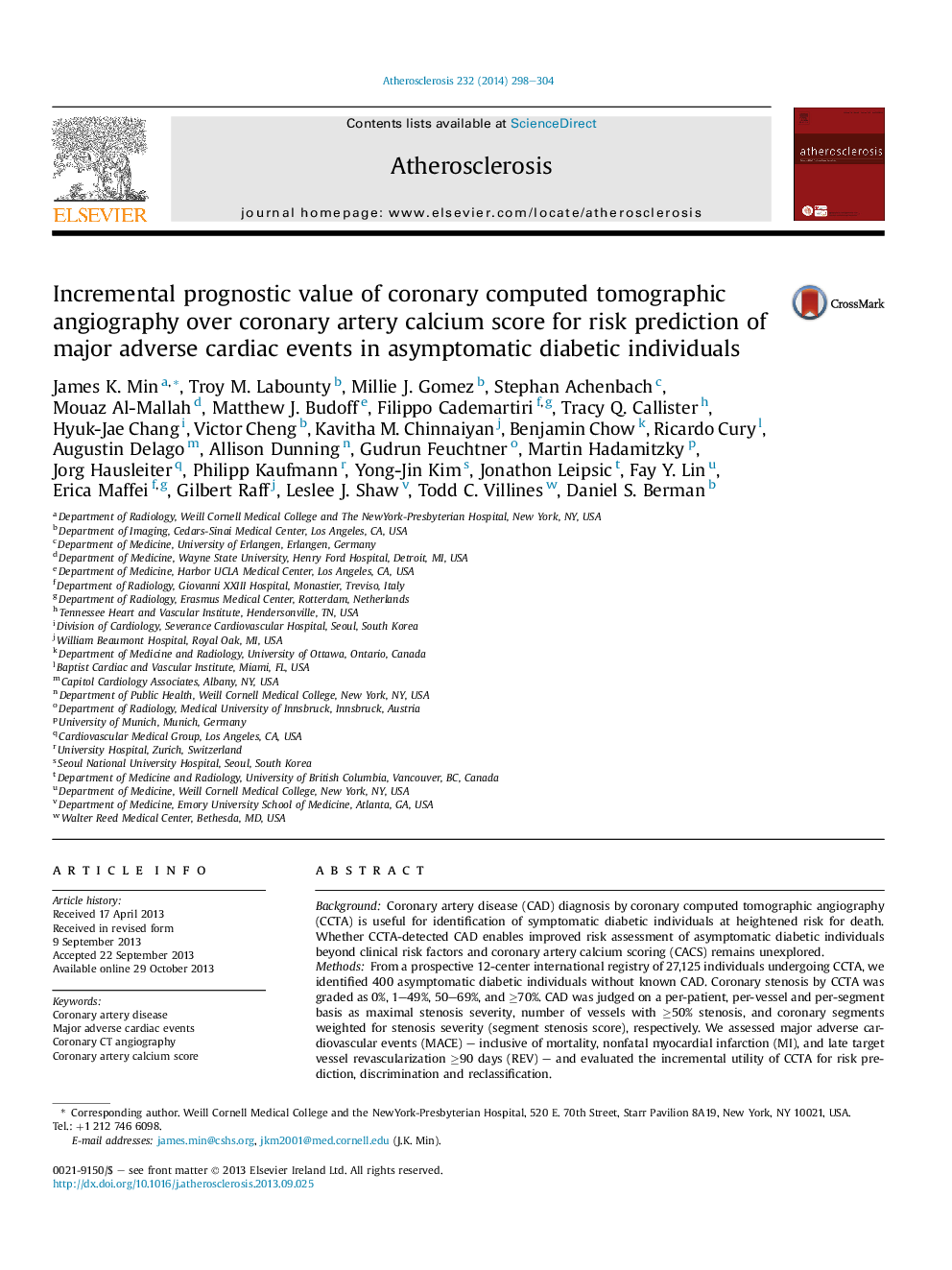| کد مقاله | کد نشریه | سال انتشار | مقاله انگلیسی | نسخه تمام متن |
|---|---|---|---|---|
| 5946836 | 1172362 | 2014 | 7 صفحه PDF | دانلود رایگان |
- We examined 400 asymptomatic diabetic patients without known coronary artery disease (CAD) who underwent both coronary CT angiography (CCTA) and coronary artery calcium scoring (CACS)
- We examined the predictive value of CCTA findings over traditional clinical risk scoring and CACS.
- Beyond clinical risk factors and CACS, CCTA findings of coronary artery disease extent and severity added prediction, discrimination and reclassification for identification of diabetic individuals at risk of incident major adverse cardiovascular events.
BackgroundCoronary artery disease (CAD) diagnosis by coronary computed tomographic angiography (CCTA) is useful for identification of symptomatic diabetic individuals at heightened risk for death. Whether CCTA-detected CAD enables improved risk assessment of asymptomatic diabetic individuals beyond clinical risk factors and coronary artery calcium scoring (CACS) remains unexplored.MethodsFrom a prospective 12-center international registry of 27,125 individuals undergoing CCTA, we identified 400 asymptomatic diabetic individuals without known CAD. Coronary stenosis by CCTA was graded as 0%, 1-49%, 50-69%, and â¥70%. CAD was judged on a per-patient, per-vessel and per-segment basis as maximal stenosis severity, number of vessels with â¥50% stenosis, and coronary segments weighted for stenosis severity (segment stenosis score), respectively. We assessed major adverse cardiovascular events (MACE) - inclusive of mortality, nonfatal myocardial infarction (MI), and late target vessel revascularization â¥90 days (REV) - and evaluated the incremental utility of CCTA for risk prediction, discrimination and reclassification.ResultsMean age was 60.4 ± 9.9 years; 65.0% were male. At a mean follow-up 2.4 ± 1.1 years, 33 MACE occurred (13 deaths, 8 MI, 12 REV) [8.25%; annualized rate 3.4%]. By univariate analysis, per-patient maximal stenosis [hazards ratio (HR) 2.24 per stenosis grade, 95% confidence interval (CI) 1.61-3.10, p < 0.001], increasing numbers of obstructive vessels (HR 2.30 per vessel, 95% CI 1.75-3.03, p < 0.001) and segment stenosis score (HR 1.14 per segment, 95% CI 1.09-1.19, p < 0.001) were associated with increased MACE. After adjustment for CAD risk factors and CACS, maximal stenosis (HR 1.80 per grade, 95% CI 1.18-2.75, p = 0.006), number of obstructive vessels (HR 1.85 per vessel, 95% CI 1.29-2.65, p < 0.001) and segment stenosis score (HR 1.11 per segment, 95% CI 1.05-1.18, p < 0.001) were associated with increased risk of MACE. Beyond age, gender and CACS (C-index 0.64), CCTA improved discrimination by maximal stenosis, number of obstructive vessels and segment stenosis score (C-index 0.77, 0.77 and 0.78, respectively). Similarly, CCTA findings improved risk reclassification by per-patient maximal stenosis [integrated discrimination improvement (IDI) index 0.03, p = 0.03] and number of obstructive vessels (IDI index 0.06, p = 0.002), and by trend for segment stenosis score (IDI 0.03, p = 0.06).ConclusionFor asymptomatic diabetic individuals, CCTA measures of CAD severity confer incremental risk prediction, discrimination and reclassification on a per-patient, per-vessel and per-segment basis.
Journal: Atherosclerosis - Volume 232, Issue 2, February 2014, Pages 298-304
